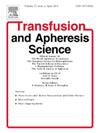Pediatric therapeutic plasma exchange: A comparative assessment of membrane and centrifugal techniques
IF 1.2
4区 医学
Q4 HEMATOLOGY
引用次数: 0
Abstract
Introduction
Therapeutic plasma exchange (TPE) is a critical extracorporeal procedure for removing pathogenic substances from plasma, commonly used in autoimmune, hematologic, and neurological disorders. While both membrane-based (mTPE) and centrifugal TPE (cTPE) are effective, comparative data in pediatric patients remain limited.
Methods
This retrospective study analyzed 94 TPE procedures performed at a tertiary hospital between August 2023 and December 2024.
Results
Patients underwent either cTPE (36.2 %) or mTPE (63.8 %), with fresh frozen plasma as the primary replacement fluid. cTPE was associated with shorter procedure duration and greater lactate reduction (p < 0.001, p = 0.003, respectively), whereas mTPE required higher blood flow rates. No significant differences were observed in hemoglobin, hematocrit, platelet counts, or coagulation parameters. Complications occurred in 56.4 % of cases, with hypotension exclusively in cTPE and circuit clotting only in mTPE.
Conclusion
Although both methods showed similar efficacy in laboratory parameters, cTPE was found to be more advantageous in terms of processing time and lactate level reduction. Procedural differences and divergence in complication profiles highlight the importance of individualized method selection based on patient characteristics. Future multi-center studies with standardized protocols are essential to optimize pediatric TPE strategies and improve clinical outcomes.
儿科治疗性血浆交换:膜和离心技术的比较评估
治疗性血浆置换(TPE)是一种从血浆中去除致病性物质的重要体外手术,常用于自身免疫性、血液学和神经系统疾病。虽然膜基(mTPE)和离心TPE (cTPE)都是有效的,但在儿科患者中的比较数据仍然有限。方法回顾性分析2023年8月至2024年12月在某三级医院进行的94例TPE手术。结果患者接受cTPE(36.2% %)或mTPE(63.8 %),以新鲜冷冻血浆作为主要替代液。cTPE与更短的手术时间和更大的乳酸减少相关(p <; 0.001,p = 0.003分别),而mTPE需要更高的血流量。在血红蛋白、红细胞压积、血小板计数或凝血参数方面没有观察到显著差异。56.4% %的病例出现并发症,cTPE患者出现低血压,mTPE患者出现循环凝血。结论虽然两种方法在实验参数上的效果相似,但cTPE在处理时间和降低乳酸水平方面更有优势。手术上的差异和并发症的差异突出了根据患者特征选择个性化方法的重要性。未来采用标准化方案的多中心研究对于优化儿童TPE策略和改善临床结果至关重要。
本文章由计算机程序翻译,如有差异,请以英文原文为准。
求助全文
约1分钟内获得全文
求助全文
来源期刊
CiteScore
3.60
自引率
5.30%
发文量
181
审稿时长
42 days
期刊介绍:
Transfusion and Apheresis Science brings comprehensive and up-to-date information to physicians and health care professionals involved in the rapidly changing fields of transfusion medicine, hemostasis and apheresis. The journal presents original articles relating to scientific and clinical studies in the areas of immunohematology, transfusion practice, bleeding and thrombotic disorders and both therapeutic and donor apheresis including hematopoietic stem cells. Topics covered include the collection and processing of blood, compatibility testing and guidelines for the use of blood products, as well as screening for and transmission of blood-borne diseases. All areas of apheresis - therapeutic and collection - are also addressed. We would like to specifically encourage allied health professionals in this area to submit manuscripts that relate to improved patient and donor care, technical aspects and educational issues.
Transfusion and Apheresis Science features a "Theme" section which includes, in each issue, a group of papers designed to review a specific topic of current importance in transfusion and hemostasis for the discussion of topical issues specific to apheresis and focuses on the operators'' viewpoint. Another section is "What''s Happening" which provides informal reporting of activities in the field. In addition, brief case reports and Letters to the Editor, as well as reviews of meetings and events of general interest, and a listing of recent patents make the journal a complete source of information for practitioners of transfusion, hemostasis and apheresis science. Immediate dissemination of important information is ensured by the commitment of Transfusion and Apheresis Science to rapid publication of both symposia and submitted papers.

 求助内容:
求助内容: 应助结果提醒方式:
应助结果提醒方式:


